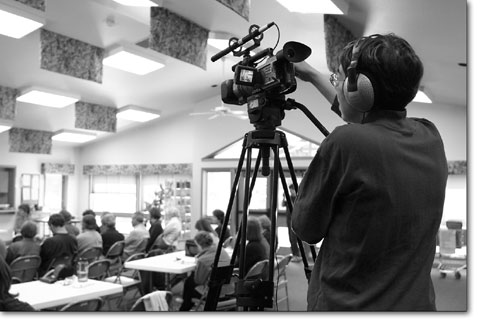| ||
DCAT faces uncertain future
by Ken Wright MTV it’s not. Tune to channel 22 on Durango’s cable TV lineup, and you will see neither commercials nor professionally produced programming. You could see, though, a gardening show, a talk show, a game show, a documentary on oil and gas issues, a church service, a college lecture, or a hockey game – all starring the same people you might see at the grocery store or sit next to at the bar. For the past six years, Durangoans have had a channel of their own to watch shows of local interest. In addition, they have had the tools and production facilities to make that programming, thanks to Durango Community Access Television. “It’s hard for some people to turn on channel 22 and see amateur video. But this isn’t commercial TV. It’s public access,” says DCAT Executive Director Jeanne Costello. The difference between DCAT and other television stations, she explains, is, the content is not determined by the audience, “but by the people who want to speak.” However, the fate of these opportunities is hanging in the balance, as the City of Durango and Bresnan Communications, which is required by law to devote space for the programming, renegotiate terms of a 15-year contract. PEG channels – public education and government channels – have been around since the 1960s, most familiarly in the form of PBS and government broadcasts like CSPAN. What’s less known, though, is that space for local public access channels must be provided by a cable company with a contract for that town, if the community asks for it. How much that right is acted upon varies from community to community, but Durango is relatively enthusiastic about PEG channels, says Costello. For more than a decade, Durango has had Cityspan 10, which televises City Council meetings and professionally produced informative programming; and Channel 15, a private, local-commercial channel. In 1999, though, a group of Durangoans got together and decided to “put the P and E into Durango’s PEG,” says Costello. DCAT was born. DCAT, says Costello, wanted to provide content not just produced locally, but “developed communally” by providing the resources and training so anyone could create and air programming. To produce a show, one need only become a member ($25 per year for an individual, $10 for students), take workshops on video production, and pay a $5 user fee for the equipment. DCAT provides technical support and reserves the right to air whatever is produced. “We want people to have success and will help them get from beginning to the end of the project,” explains Costello. In a survey done in 2004, residents reported using DCAT equipment to create more than 340 local programs that aired on the station. In 2005, more than 80 local nonprofits used DCAT to spread their messages. Presently, DCAT reaches some 6,000 households in the Durango and Hermosa areas – an estimated three quarters of which tune into DCAT at least once a week. The most common content on channel 22 are event programs, like life-long learning classes. Hockey broadcasts from the Chapman Hill rink also are popular. Two Durango churches broadcast their services. DCAT is also set up to produce edited programming, such as films and documentaries, and to film programs in talk-show format with a studio set up for multiple camera angles. DCAT even featured a game show for a while, when KDUR radio’s “Know and Win Show” moved to channel 22. In the contract that the city currently has with Bresnan Communications, the cable provider gives 4 percent of its revenue to the city to support PEG channels. Of that, DCAT receives $35,000 annually for operating expenses and $10,000 for equipment, which is augmented by underwriting and memberships. DCAT’s office, production room and talk-show set are all in a small office on the sunny side of the Smiley Building. The nonprofit group produces, on average, a new program per day and airs some 15 programs per week. Now, though, the city and Bresnan are negotiating a 15-year franchise renewal. The present contract expires this month, but the city recently announced a six-month extension on the contract talks. DCAT gave input on the talks but is not part of the negotiations. “Bresnan is a good provider to work with,” says Costello. “They’re reasonable in a time when a lot of companies act like Goliath, and refuse to negotiate at all. “But it takes local government to support and advocate for PEG,” she adds. “Denver and Boulder both lost public access channels in 2005, those cities decided to move toward professionally produced local programming.” Also, she adds, on the national level, the way television providers negotiate with communities is being debated in Congress. “‘Community access’ means ‘community driven,’” Costello argues. “That’s different than even PBS, which is noncommercial but still seeks popular programming, giving what the audience wants.” Channels like DCAT are different, she says, because “we’re a free-speech vehicle. We can’t say ‘no’ to something because we didn’t agree with its message.” “Equal treatment is important to having a democratic media,” she concludes. “Right now we’re deciding, ‘How commercial? How democratic? What access? For whom?’ These are the basic tools of democracy itself. And they’re being decided now, nationally and locally.” • For more information, visit www.dcat.tv
|


